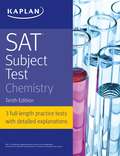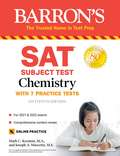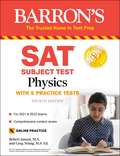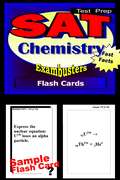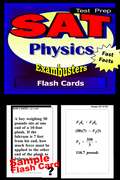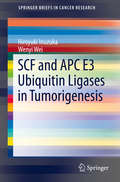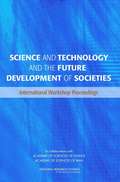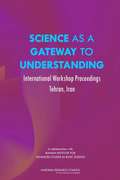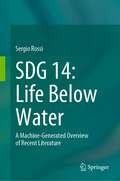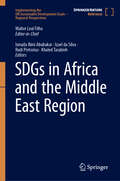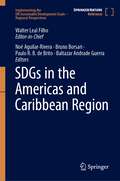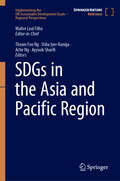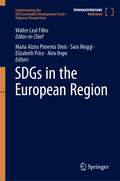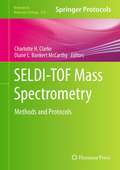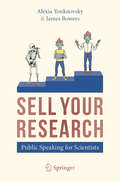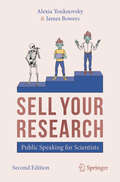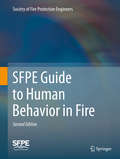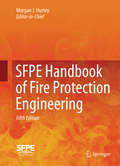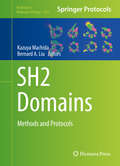- Table View
- List View
SAT Subject Test Chemistry
by KaplanEssential strategies, practice, and review to ace the SAT Subject Test Chemistry Getting into a top college has never been more difficult. Students need to distinguish themselves from the crowd, and scoring well on an SAT Subject Test gives students a competitive edge. Kaplan’s SAT Subject Test Chemistry is the most up-to-date guide on the market with complete coverage of both the content review and strategies students need for success on Test Day. Kaplan’s SAT Subject Test Chemistry features: * A full-length diagnostic test * 3 full-length practice tests * Focused chapter summaries, highlights, and quizzes * Detailed answer explanations * Proven score-raising strategies * End-of-chapter quizzes Kaplan is serious about raising students’ scores—we guarantee students will get a higher score, or get their money back.
SAT Subject Test Chemistry: with 7 Practice Tests (Barron's SAT)
by Joseph A. Mascetta M.S. Mark Kernion M.A.The updated edition of Barron's SAT Subject Test: Chemistry includes:A full-length diagnostic test with explained answersFour practice tests that reflect the actual SAT Subject Test ChemistryAll questions answered and explainedDetailed reviews covering all test topicsAppendixes, which include the Periodic Table; important equation, constant, and data tables; and a glossary of chemistry termsBoth teachers and test-taking students have praised earlier editions of this manual for its wealth of well-organized detail. Subject reviewed include the basics—matter, energy, scientific method, and measurements; atomic structure and the periodic table; bonding; chemical formulas; gases and laws; stoichiometry; liquids, solids, and phase changes; chemical reactions and thermochemistry; chemical reactions; chemical equilibrium; acids, bases, and salts; oxidation-reduction; carbon and organic chemistry; and the laboratory.ONLINE PRACTICE TESTS: Students who purchase this book or package will also get access to two additional full-length online SAT Chemistry subject tests with all questions answered and explained.
SAT Subject Test Physics: With Online Tests (Barron's Test Prep)
by Robert Jansen M.A. Greg Young M.S. Ed.Barron's SAT Subject Test Physics is updated to reflect the current test and features three full-length practice tests along with detailed content review and expert tips to help students improve their score.This edition includes:One diagnostic test to determine strengths and weaknessesThree complete SAT Subject Tests in Physics, which reflect the most recent actual tests in length, subject matter, and degree of difficultyAnswers and explanations for all questionsSelf-assessment guides after each test so students can measure their progressExtensive subject review covering all topics on the test, including mechanics, electricity and magnetism, waves and optics, thermodynamics, and more.Online Practice Test: Students also get access to one brand new, full-length online practice test with all questions answered and explained.Unique features include a &“What&’s the Trick?&” approach to solving problems quickly and effectively. Additional tips, called out with &“If You See…&” are included within the chapters to give test takers critical insight into difficult concepts, and QR codes are provided at &“Key Concept&” areas link to short videos to enhance instruction. The authors also provide general examination strategies and a detailed appendix with equations, physical constants, and a basic math review.
SAT Test Prep Flash Cards: Chemistry Fast Facts (Exambusters SAT II Workbook #2)
by Ace Inc.<P><P><i>Advisory: Bookshare has learned that this book offers only partial accessibility. We have kept it in the collection because it is useful for some of our members. Benetech is actively working on projects to improve accessibility issues such as these.</i><P><P> 700 questions and answers. Essential definitions, formulas, concepts, and sample problems. <P><P>Topics: Introduction, Matter, Atoms, Formulas, Moles, Reactions, Elements, Periodic Table, Electrons, Chemical Bonds, Heat, Gases, Phase Changes, Solutions, Reaction Rates, Equilibrium, Acids and Bases, Oxidation and Reduction, Introduction to Organic Chemistry, Radioactivity.<P> EXAMBUSTERS SAT II Prep Workbooks Provide comprehensive SAT II review--one fact at a time--to prepare students to take practice SAT II tests. Each SAT II study guide focuses on fundamental concepts and definitions--a basic overview to begin studying for the SAT II exam. Up to 600 questions and answers, each volume in the SAT II series is a quick and easy, focused read. Reviewing SAT II flash cards is the first step toward more confident SAT II preparation and ultimately, higher SAT II exam scores!
SAT Test Prep Review Flash Cards: Physics (Exambusters SAT II Workbook #2 of 3)
by Ace Inc.<P><P><i>Advisory: Bookshare has learned that this book offers only partial accessibility. We have kept it in the collection because it is useful for some of our members. Benetech is actively working on projects to improve accessibility issues such as these.</i><P><P> 600 questions and answers. Essential definitions, formulas, concepts, and sample problems. <P><P>Topics: Measurement, Motion and Forces, Work and Energy, Heat and Gases, Atoms, Fluids, Sound, Light and Optics, DC Circuits, Magnetism, AC Circuits <P>EXAMBUSTERS SAT II Prep Workbooks provide comprehensive SAT II review--one fact at a time--to prepare students to take practice SAT II tests. Each SAT II study guide focuses on fundamental concepts and definitions--a basic overview to begin studying for the SAT II exam. Up to 600 questions and answers, each volume in the SAT II series is a quick and easy, focused read. Reviewing SAT II flash cards is the first step toward more confident SAT II preparation and ultimately, higher SAT II exam scores!
SBIR at the National Science Foundation
by Technology Committee on Capitalizing on Science Innovation An Assessment Of The Small Busin Program-Phase IIThe Small Business Innovation Research (SBIR) program is one of the largest examples of U. S. public-private partnerships, and was established in 1982 to encourage small businesses to develop new processes and products and to provide quality research in support of the U. S. government’s many missions. The U. S. Congress tasked the National Research Council with undertaking a comprehensive study of how the SBIR program has stimulated technological innovation and used small businesses to meet federal research and development needs, and with recommending further improvements to the program. In the first round of this study, an ad hoc committee prepared a series of reports from 2004 to 2009 on the SBIR program at the five agencies responsible for 96 percent of the program’s operations -- including the National Science Foundation (NSF). Building on the outcomes from the first round, this second round presents the committee’s second review of the NSF SBIR program’s operations. Public-private partnerships like SBIR are particularly important since today's knowledge economy is driven in large part by the nation's capacity to innovate. One of the defining features of the U. S. economy is a high level of entrepreneurial activity. Entrepreneurs in the United States see opportunities and are willing and able to assume risk to bring new welfare-enhancing, wealth-generating technologies to the market. Yet, although discoveries in areas such as genomics, bioinformatics, and nanotechnology present new opportunities, converting these discoveries into innovations for the market involves substantial challenges. The American capacity for innovation can be strengthened by addressing the challenges faced by entrepreneurs.
SBIR/STTR at the National Institutes of Health
by Technology Committee on Capitalizing on Science Innovation An Assessment Of The Small Busin Program-Phase IIThe Small Business Innovation Research (SBIR) and Small Business Technology Transfer (STTR) programs provide federal research and development funding to small businesses. In 2008, the National Research Council completed a comprehensive assessment of the SBIR and STTR programs. The first-round study found that the programs were "sound in concept and effective in practice. " Building on the outcomes from the Phase I study, this second phase examines both topics of general policy interest that emerged during the first phase and topics of specific interest to individual agencies, and provides a second snapshot to measure the program's progress against its legislative goals.
SCF and APC E3 Ubiquitin Ligases in Tumorigenesis
by Hiroyuki Inuzuka Wenyi WeiThis SpringerBrief explores the physiological roles of Skp1-Cullin1-F-box Complex (SCF) and Anaphase Promoting Complex (APC) in normal cells and in tumor formation. These two related, multi-subunit E3 ubiquitin ligase enzymes, APC and SCF are thought to be the major driving forces governing proper cell cycle progression Defective cell cycle regulation leads to genomic instability and ultimately, cancer development. Selective degradation of key cell cycle regulators by the ubiquitin-proteasome system has been proven to be a major regulatory mechanism for ensuring ordered and coordinated cell cycle progression. The SCF and APC E3 ligases have been characterized to play pivotal roles in regulating the cell cycle progression by timely degrading various critical cell cycle regulators. This Brief reviews recent studies that have shown that deregulation of signaling pathways in which the two ubiquitin ligases are involved causes aberrant cell cycle regulation, in turn leading to tumorigenesis The text also discusses how SCF and APC may present promising therapeutic targets to treat various cancers.
SCIAMACHY - Exploring the Changing Earth’s Atmosphere
by Heinrich Bovensmann Manfred GottwaldSCIAMACHY, the SCanning Imaging Absorption spectroMeter for Atmospheric CHartographY, is a passive sensor for exploring the Earth's atmosphere. It is part of the payload of the European Earth Observation mission ENVISAT, launched on 1 March 2002. SCIAMACHY observes absorption spectra of molecules from the UV (214 nm) to the short-wave infrared wavelength range (2386 nm) and derives the atmospheric composition - trace gases, aerosols, clouds - from these measurements. Having meanwhile successfully monitored and explored the Earth's atmosphere for more than 8 years, new and exciting insights into the Earth-atmosphere system are obtained. The provided global data sets do not only cover greenhouse gases and pollutants in the troposphere or the ozone chemistry in the stratosphere but even reach up to the mesosphere and lower thermosphere. They contribute significantly to atmospheric physics and chemistry as well as climate change research. SCIAMACHY is one of the major current Earth Observation undertakings of Germany, The Netherlands and Belgium, accomplished in cooperation with the European Space Agency (ESA). Many scientific groups at various institutes in Europe and abroad were and are actively involved in the analysis of the data. This book is a comprehensive summary describing the entire SCIAMACHY mission - from the very first ideas to the current results. It illustrates how the measurements are performed, how the trace gas concentrations are derived from the measured spectra and how the unique data sets are used to improve our understanding of the changing Earth's atmosphere. The targeted readership is not only the existing and potentially new SCIAMACHY data users from undergraduate student level up to researchers new in the fields of atmospheric chemistry and remote sensing, but anyone who is keen to learn about SCIAMACHY's efforts to study the atmosphere and its responses to both, natural phenomena and anthropogenic effects.
SCIENCE AND TECHNOLOGY AND THE FUTURE DEVELOPMENT OF SOCIETIES: International Workshop Proceedings
by National Research Council of the National AcademiesIn June 2006, seventeen scientists and educators selected by the National Academies, the Academy of Sciences of Iran, and the Académie des Sciences of France held a workshop at the estate of the Fondation des Treilles in Toutour, France, to discuss issues concerning the role of science in the development of modern societies. Science and Technology and the Future Development of Societies includes the presentations made at the workshop and summarizes the discussions that followed the presentations. Topics of the workshop included science and society issues, the role of science and engineering in development; obstacles and opportunities in the application of science and technology to development; scientific thinking of decision makers; management and utilization of scientific knowledge; and science, society, and education. This book also provides useful background for the further development of interactions of Western scientists and educators with Iranian specialists.
SCIENCE AS A GATEWAY TO UNDERSTANDING: International Workshop Proceedings Tehran, Iran
by National Research Council of the National AcademiesIn October 2007, the U.S. National Academies and the Iranian Institute for Advanced Studies in Basic Science organized the first of a series of planned U.S.-Iranian workshops on the topic "Science as a Gateway to Understanding." This new workshop series is a component of the broader effort of the National Academies to support bilateral workshops and exchange visits in a variety of fields with a number of Iranian institutions that began in 2000. This book includes papers that were presented at the workshop and summaries of the discussions that followed some of the presentations. At the conclusion of the workshop there was general agreement that the presentations on many aspects of science and scientific cooperation that have a bearing on mutual understanding were an important first step. Several participants underscored that the next workshop should emphasize how scientific cooperation can lead in concrete terms to improved understanding among both academic and political leaders from the two countries.
SCIENCE Matter and Energy
by Foster; Parker; Shimmin; SteeleScience: Matter and Energy is written from a biblical worldview with the conviction that God is the Creator and Sustainer of the universe. Through this text, students will investigate chemistry and physics topics with the goal of discovering the thoughts of the Creator through the ingenious structure and orderly function of His creation (Psa. 19:1).The biblical worldview of this text naturally rejects the unproven hypothesis of evolution, recognizing special creation as the only reasonable explanation for the origin of life. Through the study of physical science, students will learn that science clearly supports the belief that the universe has a Divine Creator.
SCIENCE: Order & Design
by Dawn McKenzieExplore the many wonderful levels of creation with this colorful and beautifully designed book! From taking a look at the things you might find in your backyard to the species that occupy the rainforest, your child will receive a greater understanding of the beautiful world that God has created. Other topics included are healthy living, the miraculous stages of a baby’s development, exploring the animals of the sea, the intricate designs of the plant life, and more! Section reviews are included to support the information that your child has learned in each lesson.
SDG 14: A Machine-Generated Overview of Recent Literature
by Sergio RossiThis book focuses, in seven chapters, on the perspectives and solutions that different research groups offer to try to address problems related to SDG 14: Life Below Water. The different objectives developed in SDG 14 are treated independently, with an attempt to give a global vision of the issues. The mechanism used to select the book's content was through an Artificial Intelligence program, choosing articles related to the topics by means of keywords. The program selected those articles, and those that were not related to the topic or did not focus on SDG 14 were discarded by a subject matter expert. Obviously, the selection was partial and the entire subject is not covered, but the final product gives a very solid idea of how to orient ourselves to delve deeper into the topic of SDG 14 using published chapters and articles. The AI program itself selected the text of these contributions to show the progress in different topics related to SDG 14. This mode of operation will allow specialists (and non-specialists) to collect useful information for their specific research purposes in a short period of time. At a time when information is essential in order to move quickly by providing concrete answers to complex problems, this type of approach will become essential for researchers, especially for a subject as vast as SDG 14.
SDGs in Africa and the Middle East Region (Implementing the UN Sustainable Development Goals – Regional Perspectives)
by Walter Leal FilhoAfrica is one of the most vulnerable regions, and one where the implementation of the SDGs is particularly urgent. Underinvestments in natural conservation are increasing the vulnerability of people across many African countries, whose well-being is endangered by deteriorating socio-economic and environmental conditions. This volume provides a contribution towards showcasing how natural resources may be more efficiently used and investments may be mobilised to augment the limited public sector funds available to achieve the SDGs.This book is part of the "100 papers to accelerate the implementation of the UN Sustainable Development Goals initiative".
SDGs in the Americas and Caribbean Region (Implementing the UN Sustainable Development Goals – Regional Perspectives)
by Bruno Borsari Noé Aguilar-Rivera Paulo R. B. de Brito Baltazar Andrade GuerraThis volume provides an overview of the ways sustainable development issues as a whole, and the SDGs in particular, are perceived and practiced in a variety of countries in the Latin America and Caribbean region. It also discusses the extent to which its many socio-economic problems hinder progresses towards the pursuit of a sustainable future, and documents successful experiences from across the region.This book is part of the "100 papers to accelerate the implementation of the UN Sustainable Development Goals initiative".
SDGs in the Asia and Pacific Region (Implementing the UN Sustainable Development Goals – Regional Perspectives)
by Walter Leal Filho Ayyoob Sharifi Usha Iyer-Raniga Artie Ng Theam Foo NgThe Asia and the Pacific region is actively seeking ways to optimise the use and availability of its natural resources, which have been contributing to environmental degradation and hindering its sustainable development. This volume documents and promotes various initiatives showcasing the efforts countries in the region are making towards the implementation of the SDGs.This book is part of the "100 papers to accelerate the implementation of the UN Sustainable Development Goals initiative".
SDGs in the European Region (Implementing the UN Sustainable Development Goals – Regional Perspectives)
by Sara Moggi Elizabeth Price Maria Alzira Pimenta Dinis Alex HopeThis volume describes the thinking on sustainable development and a variety of initiatives across Europe, illustrating regional efforts to foster sustainable communities and ecological and social innovation. It contains various contributions which showcase examples of thinking, economic and social structures and in consumption and production patterns needed, to implement the SDGs.This book is part of the "100 papers to accelerate the implementation of the UN Sustainable Development Goals initiative".
SELDI-TOF Mass Spectrometry
by Charlotte H. Clarke Diane L. MccarthySELDI is distinct from other TOF-MS technologies in that it couples features of chromatography and mass spectrometry, facilitating analyte enrichment and sample cleanup on an array surface. In the growing field of proteomics, SELDI technology has been widely used for biomarker discovery and characterization in diverse applications including diagnostics, drug development, and basic research. SELDI-based biomarker studies can typically be divided into four phases: discovery, validation, purification and identification, and assay development. SELDI-TOF Mass Spectrometry: Methods and Protocols provides an overview of the current applications of SELDI-TOF MS (surface enhanced laser desorption/ionization time-of-flight mass spectrometry), with an emphasis on study and experimental design, data analysis and interpretation, and assay development. Written in the highly successful Methods in Molecular BiologyTM series format, chapters contain introductions to their respective topics, lists of the necessary materials and reagents, step-by-step, readily reproducible laboratory protocols, and notes on troubleshooting and avoiding known pitfalls. Authoritative and accessible, SELDI-TOF Mass Spectrometry: Methods and Protocols will provide information on optimizing study design, experimental protocols, and data analysis and interpretation to yield robust biomarkers and biomarker assays, using examples from different disease areas.
SELL YOUR RESEARCH: Public Speaking for Scientists
by Alexia Youknovsky James BowersPublic speaking is an essential component in the life of a scientist, whatever your level of career. In this book, the authors describe a tried-and-tested technique for preparing a presentation: the SELL Method. Following these three simple steps - Skeleton, Envelope, Life & Logistics - will help you make the most out of any talk. Whether it be a 3-minute pitch or an hour-long plenary session, you will find pages of advice, theory and practical exercises enabling you to SELL YOUR RESEARCH with impact.For scientists these days, the work is not done until it is communicated. And now that problem is solved. Solidly researched and immaculately written, Sell Your Research is a goldmine of useful advice. Whether you are brimming with confidence or just setting out, this gem of a guidebook will improve every presentation and nurture every budding science communicator.Dr. Stephen Webster, Director of Science Communication Unit, Imperial College LondonPublic speaking is one of the most intimidating but crucial tasks in a scientist’s career. This book provides a welcoming, clear, step-by-step guide to improving your presentations at every level. Reading it and following its advice will make your science talks less frightening and more enjoyable. Dr. Laura Helmuth, Health, Science & Environment Editor, Washington Post
SELL YOUR RESEARCH: Public Speaking for Scientists
by Alexia Youknovsky James BowersPublic speaking is an essential component in the life of a scientist, whatever your level of career. In this book, the authors describe a tried-and-tested technique for preparing a presentation: the SELL method. Following these three simple steps—Skeleton, Envelope, and Life and Logistics—will help you make the most out of any talk. Whether it be a 3-minute pitch or an hour-long plenary session, you will find pages of advice, theory, and practical exercises enabling you to Sell Your Research with impact. This second edition is enriched with new insights in storytelling, online presenting, and speaking with the media on hot topics. For scientists these days, the work is not done until it is communicated. And now that problem is solved. Solidly researched and immaculately written, Sell Your Research is a goldmine of useful advice. Whether you are brimming with confidence or just setting out, this gem of a guidebook will improve every presentation and nurture every budding science communicator. Dr. Stephen Webster, former Director of Science Communication Unit, Imperial College London Public speaking is one of the most intimidating but crucial tasks in a scientist’s career. This book provides a welcoming, clear, step-by-step guide to improving your presentations at every level. Reading it and following its advice will make your science talks less frightening and more enjoyable. Dr. Laura Helmuth, Editor In Chief, Scientific American
SEPUP Science and global Issues Biology
by Lab-AidsSepup's science and global issues: biology is a different kind of science course in three important ways. First, it is student-centered, with the goal of helping all students to understand and enjoy science. Second, it is authentic to the way scientists work, and it asks you to begin to think and investigate as a scientist does. Finally, it is organized around important global issues related to sustainability. Students and their teachers around the United States tested this course and gave feedback, which we used to revise and improve the program. From this testing we learned what high school students find interesting, what is easier or more difficult for you to learn, and how to provide learning experiences to help you progress in your understanding of science. During this course you will participate in a wide range of activities, including hands-on labs, hands-on models, interactive computer simulations of scientific concepts, readings describing how scientific theories are developed and are applied today, and discussions and debates. You will also connect what you learn to your own life, your community, and the world.
SFPE Guide to Human Behavior in Fire
by Society of Fire Protection EngineersThis single resource for the fire safety community distills the most relevant and useful science and research into a consensus-based guide whose key factors and considerations impact the response and behavior of occupants of a building during a fire event.The Second Edition of SFPE's Engineering Guide: Human Behavior in Fire provides a common introduction to this field for the broad fire safety community: fire protection engineers/fire safety engineers, human behavior scientists/researchers, design professionals, and code authorities. The public benefits from consistent understanding of the factors that influence the responses and behaviors of people when threatened by fire and the application of reliable methodologies to evaluate and estimate human response in buildings and structures.This Guide also aims to lessen the uncertainties in the "people components" of fire safety and allow for more refined analysis with less reliance on arbitrary safety factors. As with fire science in general, our knowledge of human behavior in fire is growing, but is still characterized by uncertainties that are traceable to both limitation in the science and unfamiliarity by the user communities. The concepts for development of evacuation scenarios for performance-based designs and the technical methods to estimate evacuation response are reviewed with consideration to the limitation and uncertainty of the methods. This Guide identifies both quantitative and qualitative information that constitutes important consideration prior to developing safety factors, exercising engineering judgment, and using evacuation models in the practical design of buildings and evacuation procedures. Besides updating material in the First Edition, this revision includes new information on:Incapacitating Effects of Fire Effluent & Toxicity Analysis MethodsOccupant Behavior ScneariosMovement Models and Behavioral ModelsEgress Model Selection, Verification, and ValidationEstimation of Uncertainty and Use of Safety FactorsEnhancing Human Response to Emergencies & Notification of MessagingThe prediction of human behavior during a fire emergency is one of the most challenging areas of fire protection engineering. Yet, understanding and considering human factors is essential to designing effective evacuation systems, ensuring safety during a fire and related emergency events, and accurately reconstructing a fire.
SFPE Handbook of Fire Protection Engineering
by John R. Hall Morgan J. Hurley Daniel Gottuk Kazunori Harada Erica Kuligowski Milosh Puchovsky José Torero John M. Watts Christopher WieczorekRevised and significantly expanded, the fifth edition of this classic work offers both new and substantially updated information. As the definitive reference on fire protection engineering, this book provides thorough treatment of the current best practices in fire protection engineering and performance-based fire safety. Over 130 eminent fire engineers and researchers contributed chapters to the book, representing universities and professional organizations around the world. It remains the indispensible source for reliable coverage of fire safety engineering fundamentals, fire dynamics, hazard calculations, fire risk analysis, modeling and more. With seventeen new chapters and over 1,800 figures, the this new edition contains: * Step-by-step equations that explain engineering calculations * Comprehensive revision of the coverage of human behavior in fire, including several new chapters on egress system design, occupant evacuation scenarios, combustion toxicity and data for human behavior analysis * Revised fundamental chapters for a stronger sense of context * Added chapters on fire protection system selection and design, including selection of fire safety systems, system activation and controls and CO2 extinguishing systems * Recent advances in fire resistance design * Addition of new chapters on industrial fire protection, including vapor clouds, effects of thermal radiation on people, BLEVEs, dust explosions and gas and vapor explosions * New chapters on fire load density, curtain walls, wildland fires and vehicle tunnels * Essential reference appendices on conversion factors, thermophysical property data, fuel properties and combustion data, configuration factors and piping properties.
SH2 Domains
by Kazuya Machida Bernard A. LiuThis volume covers an array of techniques available for studying SH2 domains and phosphotyrosine signaling. The book is divided into six parts: Part I outlines the history of SH2, technology development, and cell signaling; Part II focuses on computational approaches and tools used for identification, classification, and predictions of SH2 domain binding partners; Part III details various ways to prepare the SH2 domains as experimental reagents; Part IV presents methods for structural analysis and conventional binding assays using SH2 domains; Part V describes high-throughput and proteomics approaches to aid in analyzing SH2-mediated interactions; and Part VI covers applications for SH2 domain to functional and imaging analyzes. Written in the highly successful Methods in Molecular Biology series format, chapters include introductions to their respective topics, lists of the necessary materials and reagents, step-by-step, readily reproducible laboratory protocols, and tips on troubleshooting and avoiding known pitfalls. Cutting-edge and thorough, SH2 Domains: Methods and Protocols is a valuable resource for computational biologists, biochemists, structural biologists, cell biologists, pathologists, and people interested in SH2 domains and phosphotyrosine signaling. Researchers who are investigating how protein interaction domain mediate specificity in signaling systems may also find this book informative.
